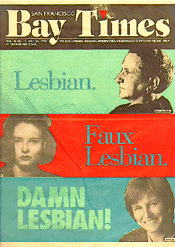 |
Pre- and Post-Stonewall Lesbian ImageryGuest Curator: A. Deborah Malmud, Department of English & Comparative Literature, Columbia University |
Forty years ago, lesbian images abounded. Mass
produced paperbacks with titles like The Girls in Three-B, Strange
Sister, and Women's Barracks could be bought for a quarter
at the corner drugstore. Often written by men, these lurid stories portrayed
sick and deviant women, destined to either unhappy marriage, suicide,
or prostitution. With sensational and explicit cover illustrations, the
books commonly featured an older, vixen-like woman luring a young, chaste,
and unsuspecting girl into the tangled we b of lesbianism. By the early
1970s, in the wake of the Stonewall Riots, lesbian imagery had been transformed.
Hand-holding, flannel shirt wearing women appeared romping through daisy
fields, their long hair flowing in the breeze. Books such as Sappho
was a Right-on Woman, Lesbian Nation, and Woman Plus Woman championed an emerging lesbian/feminist consciousness.
The 1980s and early 1990s have seen a vast transformation in lesbian imagery.
Deemed the "chic minority of the year" by Esquire magazine in 1993,
lesbians have entered popular culture in unprecedented numbers. Roberta
Achtenberg became the first openly gay presidential appointee, k.d. lang
and Melissa Etheridge have come out and remained best-selling recording
artists, and one of television's most popular sitcoms, "Roseanne," featured
a lesbian kiss. Lesbians have appeared on the covers of such mainstream
publications as New York magazine, Newsweek, and Vanity
Fair. From the dark days of images depicting women living amidst the
shadows of sexual confusion, lesbians have emerged into the spotlight,
capturing the attention of American consumers. Whether lesbians are merely
being appropriated as the latest fad, or whether this interest signifies
a more profound change in public opinion, remains to be seen.
Case Displays
- Claire Morgan [Patricia Highsmith]. The Price of Salt. New York: Bantam, 1951.
Claire Morgan was the pseud. of Patricia Highsmith, author of the novel Strangers on a Train--upon which Raymond Chandler based his screenplay for the Hitchcock film. In her popular 1951 novel, The Price of Salt, she took a radically positive stance toward lesbians. Depicting a relationship between a married woman and a younger woman, she wrote "the rapport between two men or two women can be absolute and perfect, as it never can be between man and woman . . . ." These were fighting words, particularly in the 1950s.
The text on the back cover reads: "TWO WOMEN: One was a lonely, ardent girl, besieging the walls of New York's theatrical world; the other, a beautiful, mature woman, experienced, sophisticated, but unsatisfied... The problem is dealt with gracefully and distinctively in this thoughtful, discerning novel, which faces frankly one of the basic problems of today's restless, searching, puzzled world."
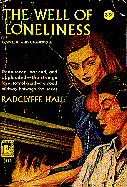 Radclyffe Hall
Radclyffe Hall - Radclyffe Hall. The Well of Loneliness. Perma Books,
1951.
Radclyffe Hall was tried for obscenity when this book--arguably the most famous lesbian novel--was originally published in London in 1928. Its British publisher, Jonathan Cape, hesitatingly agreed to a limited first edition of 1,500 copies. Since then, it has become a staple for lesbian readers all over the world. This cover is from the first mass-market, paperback edition.
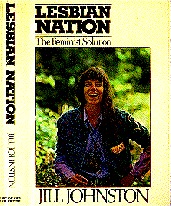 Jill Johnston
Jill Johnston - Jill Johnston. Lesbian Nation: the Feminist Solution. New York: Simon and Schuster, 1973.
When Jill Johnston came out in her Village Voice column in the early 1970s, she inaugurated a new era in print journalism. This 1973 book is a compilation of many essays she wrote for that column, and includes Johnston's controversial statement that "until all women are lesbians, there will be no true political revolution." The book's title quickly became part of popular lexicon, and its essays include "Slouching Toward Consciousness;" "The Making of a Lesbian Chauvinist;" "The Myth of the Myth of the Vaginal Orgasm;" and "Lois Lane was a Lesbian." (This particular copy--apparently originally given as a gift--is inscribed: "Dear Lynn and Vivian: You both are loving beautiful people. I appreciate you and I thank you for teaching me to be more open and unafraid. Love, Linn." and dated August 2, 1974.)


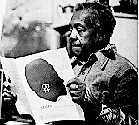


[Annie Lee Grant, Mabel Hampton] -- [Lorraine Hansberry, Audre Lorde]
- J. R. Roberts. Black Lesbians: An Annotated Bibliography. Tallahassee: Naiad Press, 1981.
Listing hundreds of books and resources focusing on black lesbians both pre- and post-Stonewall, this reference is invaluable for the gay scholar. Here, a photographic essay depicts lesbians from the Fifties and Sixties, including playwright Lorraine Hansberry and poet Audre Lorde.
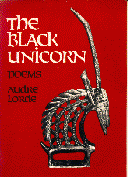 Audre Lorde
Audre Lorde - Audre Lorde, 1934-1992. The Black Unicorn: Poems. New York: Norton, 1978.
Audre Lorde's death in 1992 robbed the world of one of its most gifted writers. Author of numerous books of poetry, criticism, and memoir, Lorde described herself as a "black lesbian feminist warrior poet." She continued, "When I say myself, I mean not only the Audre who inhabits my body but all those feisty, incorrigible black women who insist on standing up and saying 'I am and you cannot wipe me out, no matter how irritating I am, how much you fear what I might represent.'"
Lorde's works include The Cancer Journals, an account of her struggle with the disease; Zami: A New Spelling of My Name, a biomythography of her coming of age, and The Black Unicorn.
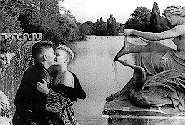 Jill Posener cover for Feminist Studies
Jill Posener cover for Feminist Studies - Feminist Studies. College Park, Maryland: Feminist Studies
Inc, in association with the Women's Studies Program at the University
of Maryland, Fall 1992.
The Fall 1993 issue of Feminist Studies was a special issue on lesbians. The cover of this academic journal uses a photo by Jill Posener, from "Dirty Girls' Guide to London" entitled LESBIAN SEX IN PUBLIC SPACES. Of this shot, Posener writes, "If we don't take public spaces nobody will hear us. The state isn't in any mood to help our cause." This issue of Feminist Studies shows the degree to which an academic publication has been radicalized--at least in so far as it chooses its cover imagery. Articles inside include discussions of the historical roots of modern lesbian identity, Afro-Caribbean lesbians, and dildoes.
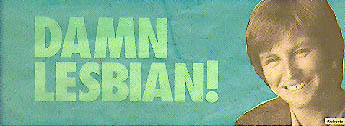
San Franciso Bay Times, Achtenberg cover - San Francisco Bay Times. May 20, 1993.
Despite a Senate committee's endorsement of President Clinton's nomination of Roberta Achtenberg as assistant HUD secretary, Senator Jesse Helms said he would fight the nomination because Achtenberg is a "damn lesbian." Achtenberg, the first openly gay presidential appointee, was later confirmed by a sweeping number. This issue of the San Francisco Bay Times takes Helms' words and uses them to make a humorous statement about lesbian visibility and pride.
 New York Magazine
New York Magazine - New York [magazine]. "You Read It Here First." [reproduction
of advertisement, 1993].
In perhaps the first example of a mainstream publication using lesbian imagery to boost sales, New York magazine ran an ad proclaiming that they were first to report the "gay story." This image is a humorous reminder that the straight world might just be a tad more interested in us than they let on. Sources in the magazine industry report that these two issues of New York and Newsweek (along with the k.d. lang Vanity Fair) were the best-selling issues of all three magazines.
 Vanity Fair
Vanity Fair - Vanity Fair. New York: Conde Nast Publications, August
1993.
When singer k.d. lang appeared with model Cindy Crawford on the cover of Vanity Fair, she changed the images of lesbians forever. Following cover stories about lesbians in the mainstream publications New York and Newsweek, this photograph is significant not only for the way it addresses gender roles, but for its sheer joy and playfulness.
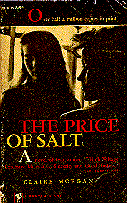 Claire Morgan [Patricia Highsmith]
Claire Morgan [Patricia Highsmith]